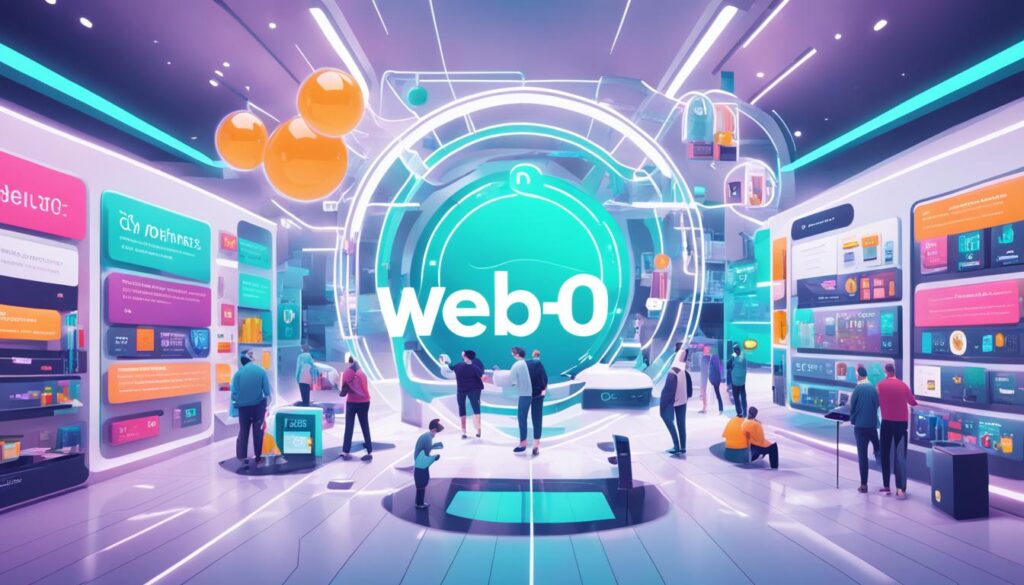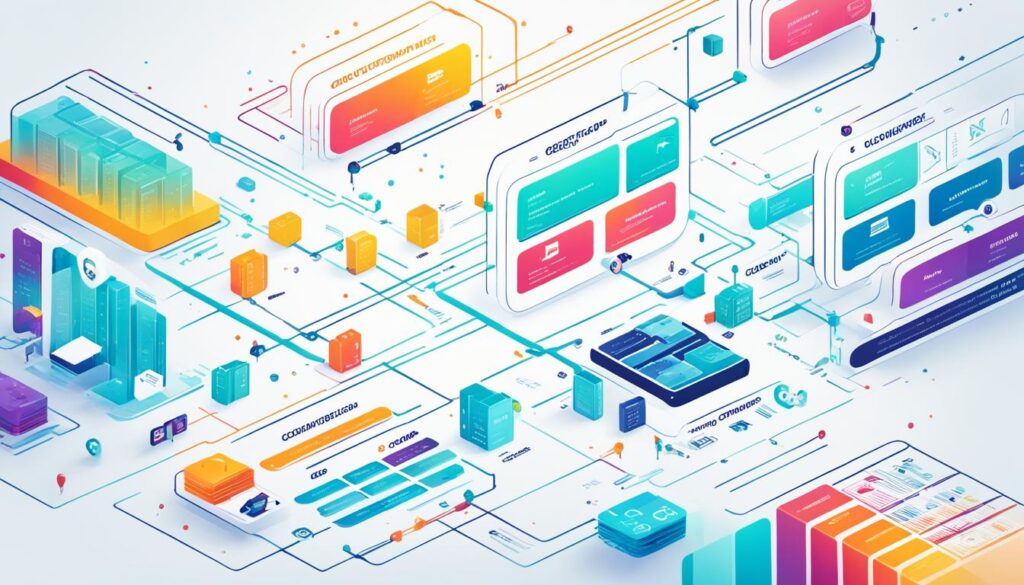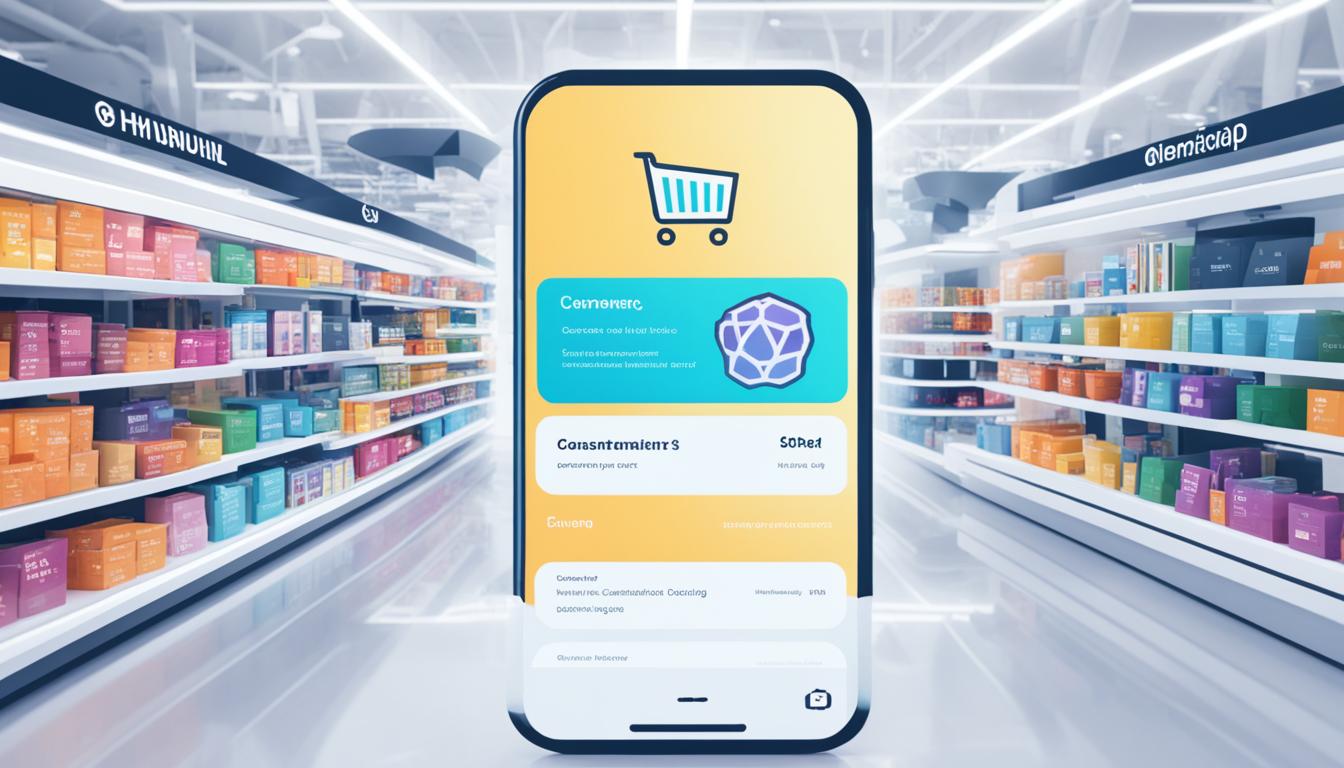Welcome to the future of e-commerce! Web 3.0, also known as the decentralized web, is set to revolutionize the way we shop online. With the integration of advanced technologies like blockchain and artificial intelligence, Web 3.0 promises to create a more personalized and secure online environment for both buyers and sellers.
This exciting transformation brings decentralized marketplaces powered by blockchain technology, eliminating middlemen and providing transparency, reduced costs, and fair transactions. By removing unnecessary intermediaries, customers can have direct interactions with sellers, ensuring a seamless shopping experience.
Key Takeaways:
- Web 3.0 is reshaping the future of e-commerce through advanced technologies like blockchain and artificial intelligence.
- Decentralized marketplaces powered by blockchain offer transparency, reduced costs, and fair transactions.
- Web 3.0 creates a more personalized and secure online environment.
- Customers can have direct interactions with sellers, ensuring a seamless shopping experience.
- The future of e-commerce in the Web 3.0 era holds immense possibilities for personalized shopping experiences and greater transparency.
Web 3.0: A Brief Overview
The evolution of the web has brought us from Web 1.0, where information was static and consumed passively, to the interactive and collaborative Web 2.0. Now, we stand at the cusp of a new era – Web 3.0. Also known as the semantic web, Web 3.0 takes the interconnectivity and user-driven content of Web 2.0 to a whole new level, incorporating cutting-edge technologies like artificial intelligence, decentralized finance, and blockchain.
At its core, Web 3.0 aims to create a more personalized and secure online environment, revolutionizing the way we interact with the digital world. With the Semantic Web, machines are able to understand and interpret the context of data, leading to more meaningful search results and recommendations.
One of the key drivers of Web 3.0 is artificial intelligence (AI). AI enables websites and applications to gather user data ethically and utilize it to offer personalized product recommendations. By analyzing user behavior and preferences, retailers can create tailored shopping experiences that resonate with customers on a deeper level.
The integration of technologies like augmented reality and virtual reality further enhances the Web 3.0 experience. Customers can now visualize products in real-time, allowing them to make more informed purchasing decisions. This immersive approach instills confidence in buyers and reduces product returns, benefiting both consumers and businesses.
Decentralized finance (DeFi) and blockchain technology are also central to the Web 3.0 landscape. DeFi provides a transparent and decentralized platform for financial transactions, eliminating the need for intermediaries. Blockchain ensures the security and integrity of these transactions, offering a level of trust that was previously difficult to achieve in traditional e-commerce.
The Benefits of Web 3.0 in E-commerce
Web 3.0 brings forth a host of benefits in the realm of e-commerce. Here are some notable advantages:
- Enhanced Personalization: Through AI algorithms and semantic analysis, retailers can deliver individually tailored shopping experiences, increasing customer satisfaction and loyalty.
- Improved Security and Trust: With blockchain technology, transactions are more secure and transparent, ensuring trust between buyers and sellers.
- Efficient Data Utilization: Web 3.0 leverages user data to provide personalized recommendations, allowing businesses to target their audience more effectively.
- Seamless Integration of Emerging Technologies: The integration of augmented reality, virtual reality, and other innovative technologies enhances the customer experience and fosters greater engagement.
Web 3.0 is not without its challenges, including the need for widespread adoption, overcoming technical hurdles, and navigating regulatory frameworks. However, the potential rewards in terms of improved user experiences, seamless transactions, and greater transparency make Web 3.0 a transformative force in the world of e-commerce.

As we embrace Web 3.0, we enter an era of unprecedented possibilities for online commerce. With its focus on personalization, user experience, and security, Web 3.0 paves the way for a revolution in e-commerce that will reshape the future of digital shopping.
Revolutionizing E-Commerce with Web 3.0
Web 3.0 is transforming the landscape of e-commerce, bringing unprecedented advancements and opportunities for businesses and consumers alike. This next generation of the internet is powered by cutting-edge technologies that enable transparency, security, and innovation. Let’s explore how Web 3.0 is revolutionizing e-commerce through:
Transparency in Supply Chain
Blockchain technology, at the core of Web 3.0, ensures transparency in the supply chain. By leveraging distributed ledgers, businesses can provide customers with real-time visibility into the journey of their products. This increased transparency builds trust and allows buyers to make informed decisions based on verifiable information.
Smart Contracts
Smart contracts are a key component of Web 3.0 that streamline the procurement process in e-commerce. These self-executing contracts automate payment and agreement terms, reducing delays and disputes. With smart contracts, buyers and sellers can engage in secure and efficient transactions, knowing that the terms will be automatically enforced.
Cryptocurrency Payments
Web 3.0 embraces the use of cryptocurrencies, such as Bitcoin and Ethereum, as a form of payment in e-commerce. Cryptocurrency payments provide a secure and borderless solution, enabling faster international transactions without the need for traditional banking intermediaries. By accepting cryptocurrencies, businesses can tap into a global customer base and offer a seamless payment experience.
NFTs in E-commerce
Non-Fungible Tokens (NFTs) are revolutionizing the concept of online ownership. In the Web 3.0 era, NFTs can authenticate and verify the ownership of digital assets, such as artwork and collectibles. This enables artists and content creators to monetize their digital creations, opening up new avenues for e-commerce. By leveraging NFTs, businesses can tap into the growing market for unique and digital goods.
Web 3.0 brings unprecedented opportunities for transparency, security, and innovation in e-commerce. By harnessing the power of blockchain, smart contracts, cryptocurrency payments, and NFTs, businesses can create a more seamless and trustworthy online shopping experience for customers. The future of e-commerce is being reshaped by Web 3.0, and businesses that embrace this transformative technology will have a competitive edge in the evolving digital landscape.

Benefits and Challenges of Web 3.0 in E-Commerce
Web 3.0 brings a range of benefits and challenges to the world of e-commerce. This section explores the advantages and obstacles associated with this transformative technology.
Benefits of Web 3.0 in E-Commerce
Web 3.0 offers enhanced transparency in e-commerce transactions, revolutionizing the way buyers and sellers interact. With blockchain technology, every transaction is recorded on a decentralized ledger, providing a transparent and immutable record of each step. This transparency fosters trust among consumers, ensuring they have access to reliable information about products, prices, and supply chain origins.
Another key benefit of Web 3.0 is increased security. Blockchain acts as a secure and decentralized infrastructure, safeguarding sensitive customer data and protecting against fraudulent activities. By eliminating centralized databases, the risk of data breaches and identity theft is significantly reduced, giving e-commerce platforms an added layer of security.
Web 3.0 also enables personalized shopping experiences tailored to individual preferences. Using advanced algorithms and artificial intelligence, e-commerce websites can analyze vast amounts of data to understand customer behavior and provide personalized product recommendations. This level of personalization enhances customer satisfaction and increases the likelihood of conversions.
Moreover, Web 3.0 empowers users with greater control and ownership over their data. Instead of companies monopolizing and profiting from user data, Web 3.0 enables individuals to determine how their data is utilized. This shift towards data ownership gives consumers the freedom to choose who has access to their information and encourages responsible data handling practices in the e-commerce industry.
Challenges of Web 3.0 in E-Commerce
Despite its numerous benefits, Web 3.0 also presents several challenges that need to be addressed for its successful implementation in the e-commerce sector. One key challenge is the adoption and understanding of Web 3.0 technologies. Educating businesses and consumers about the advantages and functionalities of Web 3.0 is crucial for widespread adoption.
Technical hurdles represent another challenge. Developing the infrastructure required to support Web 3.0 can be complex and resource-intensive. This includes integrating blockchain technology, artificial intelligence algorithms, and other advanced tools into existing e-commerce platforms. Overcoming these technical challenges requires skilled professionals and substantial investment.
Furthermore, the legal and regulatory frameworks surrounding Web 3.0 need to be navigated carefully. As the technology evolves, governments and regulatory bodies are grappling with how to address issues such as data privacy, smart contracts, and cryptocurrency payments. Striking the right balance between innovation and compliance is essential to ensure a secure and legally compliant e-commerce landscape.
| Benefits | Challenges |
|---|---|
| Enhanced transparency in transactions | Adoption and understanding |
| Increased security through blockchain | Technical hurdles in development |
| Personalized shopping experiences | Regulation and compliance |
| Greater control and ownership over data |
Despite these challenges, the potential rewards of e-commerce in the Web 3.0 era make it an exciting and transformative prospect. Embracing transparency, security, and personalization, businesses can unlock new opportunities and deliver exceptional customer experiences in the decentralized digital landscape.
Conclusion
Embracing the power of Web 3.0 technologies is not just a choice, but a necessity for the future of e-commerce. It presents businesses with an incredible opportunity to create immersive and personalized customer experiences, streamline their operations, and stay competitive in this ever-evolving market.
The fusion of Web 3.0 with the retail industry has the potential to completely transform the way we shop, interact, and transact online. Imagine a future where you can enjoy personalized shopping experiences tailored to your preferences, engage in direct peer-to-peer transactions without intermediaries, and gain greater transparency in every transaction you make.
The Web 3.0 era holds immense possibilities for the future of e-commerce. With the integration of advanced technologies like blockchain and artificial intelligence, we can expect a new wave of innovation that redefines the retail landscape. This exciting journey promises to revolutionize the way we buy and sell, and shape the retail and e-commerce industry in ways we can only imagine.
So, gear up for the future and be a part of this transformative revolution. Embrace Web 3.0, leverage its potential to its fullest, and join the vanguard of businesses that are adapting to the changing times. The future of e-commerce in the Web 3.0 era is bright, promising, and full of endless opportunities.
FAQ
What is Web 3.0 and how does it relate to e-commerce?
Web 3.0, also known as the decentralized web, incorporates advanced technologies like blockchain and artificial intelligence to reshape the future of e-commerce. It creates a more personalized and secure online environment, revolutionizing the retail and e-commerce sectors.
What are the key features of Web 3.0?
Web 3.0 incorporates technologies like artificial intelligence, decentralized finance, and blockchain. It focuses on user-driven content, interconnectivity, and enhanced user experiences, allowing retailers to gather user data ethically, offer personalized product recommendations, and provide tailored shopping experiences.
How does Web 3.0 revolutionize e-commerce?
Web 3.0 revolutionizes e-commerce by ensuring transparency in the supply chain through blockchain technology, automating payments and agreements with smart contracts, accepting cryptocurrencies for secure and borderless payments, and authenticating digital assets with Non-Fungible Tokens (NFTs) for the sale of unique items.
What are the benefits of Web 3.0 for e-commerce?
Web 3.0 offers benefits such as enhanced transparency in transactions, increased security through blockchain technology, personalized shopping experiences tailored to individual preferences, and greater control and ownership over user data.
What challenges does Web 3.0 pose for e-commerce?
Challenges include the adoption and understanding of Web 3.0, technical hurdles in developing the technology, and navigating legal and regulatory frameworks.
Why is embracing Web 3.0 essential for the future of e-commerce?
Embracing Web 3.0 technologies empowers businesses to create immersive customer experiences, streamline operations, and stay competitive in the evolving market. It redefines how we shop, interact, and transact online, offering exciting possibilities for the future of e-commerce.








